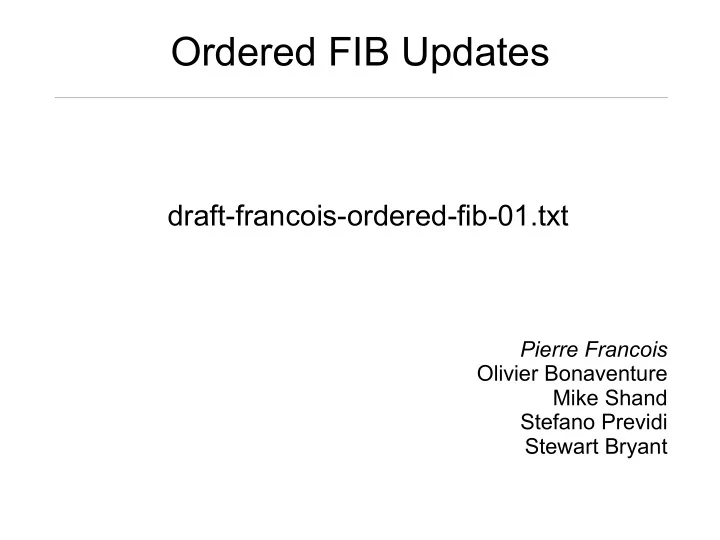

Ordered FIB Updates draft-francois-ordered-fib-01.txt Pierre Francois Olivier Bonaventure Mike Shand Stefano Previdi Stewart Bryant
Outline ● Quick reminder on ordered FIB updates ● Convergence time of ordered FIB updates ● Comparison with PLSN ● Conclusion
Ordered FIB Updates Principle – Order FIB updates on the routers to avoid transient loops – Considering the removal of a link X Y ● A router R updates its FIB after the routers that use itself to reach the removed link (X Y). – R updates its FIB after S and U – T does not wait to update its FIB – X is the last router to update its FIB
Ordered FIB Updates How to determine the correct ordering ? – Each router computes a rank ● rSPF rooted at Y gives the shortest paths to Y ● During rSPF computation – R finds its Rank, depth(R,rSPT(X Y)) ● max (hop) length among paths to R used to reach Y – R finds the set of neighbors that use it to reach (X Y ) ● Waiting List of R (used to shortcut the rank) ● R's FIB update time is Rank(R)*MAX_FIB
Ordered FIB Updates Completion messages – When a router updates its FIB ● It sends a completion message to its old nexthops for X – When a router receives a completion message ● It removes the sender from its Waiting List – When R's Waiting List becomes empty ● R can update its FIB and send its completion message – Rank timer recovers from lost completion messages
Simulation results Ordered FIB convergence time ● The time to perform an ordered FIB update after a link-state change, by considering – The flooding of the link-state packet across the network ● Link delay ● LSP processing in the router (4 msec) – The computation time of the (r)SPT (once LSP is received) ● This is assumed to take 200 msec – The time required to update a FIB ● 100 µsec / prefix (measured on Cisco 12k) – The time required to process a completion message ● This is assumed to take 4 msec ● Convergence is reached when all FIBs have been updated and no more completion messages are sent
First case study Geant ● 22 routers in Europe – 1 access router in New-York ● 36 links (72 directed links) ● 1 asymmetrical link metric (X Y) (Y X) ● Few prefixes advertised by each router
First case study Geant – Convergence time with Ordered FIB similar to Normal Convergence Time
Second topology A tier-1 ISP ● 208 routers ● 391 links ● 85 asymmetrical link metrics – Asymmetrical link metrics are not academic issues ● Large number of prefixes advertised by each router
Second topology A tier-1 ISP – Worst convergence time is 861 ms ● A branch of 4 routers in the rSPT with a full FIB update to perform, each taking more than 100 ms – 23 directed links do not carry packets – Convergence time with Ordered FIB similar to Normal Convergence Time
oFIB and PLSN A replacement or a next-step ? ● Path Locking via Safe Neighbours – Basic Solution to Provide loop-free convergence ● Does not provide 100% coverage – Some toplogy changes cannot be supported (loops still occur) – Issues with asymmetrical metrics (solution reduces the coverage) ● A Router updates its FIB after 0, 2 or 4 seconds depending on PLSN type of the rerouted prefixes ● Ordered FIB updates – Complete Solution ● Provides 100% loop-free convergence for – link/router/linecard manual up/down, IGP metric tuning – sudden failures when a local protection is provided ● A Router updates its FIB after (rank * max_fib), in one shot – worst-case rank is the longest (in hops) path in the network ● Sub-second convergence time can be achieved with completion messages, rank time only applies if CM are lost
Conclusion ● Ordered FIB updates can provide sub-second loop- free convergence in IS-IS and OSPF networks – Full coverage – Simulations indicate that Ordered convergence is not significantly slower than normal IGP convergence ● If completion messages are used ● Adoption of draft-francois-ordered-fib-01.txt as WG document – Requested in November 2005 for previous version – Comments raised on mailing list addressed by this draft – There is an existing implementation
References [1] Achieving subsecond IGP convergence in large IP networks ● P. Francois, C. Filsfils, J. Evans, O. Bonaventure, In ACM SIGCOMM Computer Communications Review, July 2005 draft-bonaventure-isis-ordered-00.txt ● Avoiding transient loops during IGP convergence in IP networks, ● P. Francois, O. Bonaventure, In proceedings of IEEE INFOCOM 2005
Recommend
More recommend